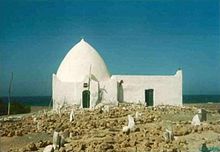Habar yunis
|
|
|

The tomb of Sheikh Isaaq, the founding father of the Isaaq clan, in Maydh, Sanaag.
|
|
| Regions with significant populations | |
|---|---|
| Languages | |
| Somali | |
| Religion | |
| Islam (Sunni ) | |
| Related ethnic groups | |
| Dir, Darod, Hawiye, Rahanweyn, and other Somali people |
The Isaaq (also Isaq, Ishaak) (Somali: Reer Sheekh Isaxaaq, Arabic: إسحاق) is a noble Somali clan. It is one of the major Somali clans, with a large and densely populated traditional territory. Members principally live in Somaliland the Somali Region of Ethiopia and Djibouti, as well as Kenya where they are known as the Isahakia community.
The populations of five major cities in Somaliland – Hargeisa, Burao, (second and third largest Somali cities respectively) Berbera, Erigavo and Gabiley – are predominantly Isaaq.
According to some genealogical books and Somali tradition, the Isaaq clan was founded in the 13th or 14th century with the arrival of Sheikh Isaaq Bin Ahmed Bin Mohammed Al Hashimi (Sheikh Isaaq) from Arabia, a descendant of Ali ibn Abi Talib in Maydh. He settled in the coastal town of Maydh in modern-day nnorthwestern Somaliland, where he married into the Magaadle clan.
There are also numerous existing hagiologies in Arabic which describe Sheikh Isaaq's travels, works and overall life in modern Somaliland , as well as his movements in Arabia before his arrival. Besides historical sources, one of the more recent printed biographies of Sheikh Isaaq is the Amjaad of Sheikh Husseen bin Ahmed Darwiish al-Isaaqi as-Soomaali, which was printed in Aden in 1955.
Sheikh Isaaq's tomb is in Maydh, and is the scene of frequent pilgrimages. Sheikh Isaaq's mawlid (birthday) is also celebrated every Thursday with a public reading of his manaaqib (a collection of glorious deeds). His Siyaara or pilgrimage is performed annually both within Somaliland and in the diaspora particularly in the middle east among Isaaq expatriates.
...
Wikipedia
